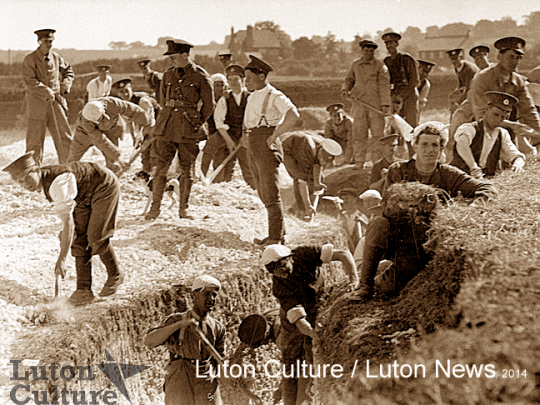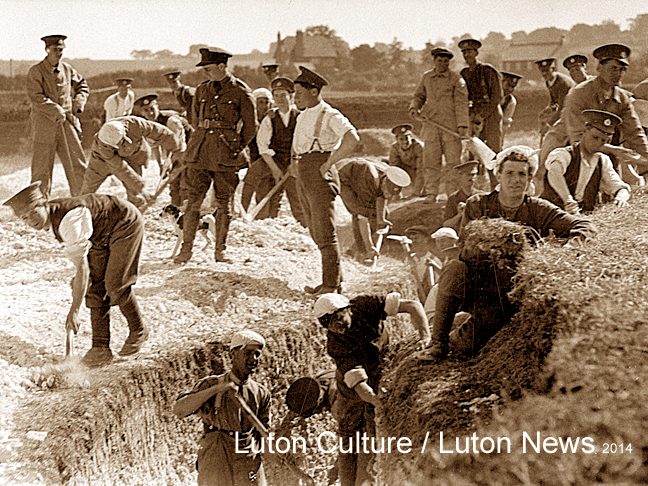Trench warfare in Bedfordshire
Event date
Classifications
Source
Source Date

- Trench digging practice on Dallow Downs.
By far the most realistic work that the soldiers stationed in and around Luton have experienced in their present training took place last week, culminating in a big battle at dawn on Friday.
The operations were on a very large scale. It was no afternoon picnic. It was three days of very hard work, but nevertheless it was an experience which the majority of the men at any rate would not have missed for worlds.
The area stretched from Sharpenhoe Point (on the left as one goes down Barton Cutting) across the hills to Sundon - a frontage of about five miles. The situation was ideal. The hills drop quickly down to the plains which stretch for miles, and although the hedges and wood give cover under which an enemy can approach, the defenders have a wide sweep of the surrounding countryside.
Work commenced on Tuesday with the digging of trenches. These were made exactly as the Regular Army would do. Those for the infantry were six feet deep, with two ledges in the front, one of which to stand and the other on which to rest the elbow when shooting. The trenches also had little gullies at the bottom to take away water, should rain fall.
In the rear were trenches for the supporting parties, the connecting trench through which the wounded are taken back and supports brought up, being covered with splinter-proof material. The trenches were made in a zig-zag fashion to prevent an enfilading fire by the enemy.
All the brigades of infantry were entrenched in this manner and behind them were the artillery. The scheme for entrenching and protecting the big guns had been carried out in a manner which earned compliments from soldiers as well as the few civilians who saw it. The idea of the whole scheme was that a big stand should be made on these hills against the enemy. For that reason the trenches were not of a temporary nature.
The men worked at them on Tuesday and Wednesday morning, returning to their usual quarters each day, but on Thursday morning at about six o'clock they started out with their blankets and waterproofs in addition to their usual pack.
On arrival at the trenches they began the final preparations, and it was a very interesting sight to see the officers as well as the men with their tunics off and shirt sleeves rolled up, slogging away at the job for all they were worth. Many a smooth palm became rough and sore during the making of these trenches, but afterwards the hands were regarded as something worth showing - and so they were.
With the troops were their field kitchens, and the meals were served to the soldiers on the spot. There was something to keep the men employed continually. Outposts and pickets were placed in anticipation of an attack from the north, and the men bivouacked at night behind the lines. But they had only a few hours sleep because of an impending attack.
It was thought by many of the men that the Highlanders from Bedford would form the attacking party, but as a matter of fact this had never been contemplated. Instead, the Lincoln and Leicester Brigade who had been entrenched on Sharpenhoe Point, were transformed into the enemy.
Quietly, just after midnight, they slipped out of their trenches and in the darkness they performed an eight mile march in a semi-circular sweep - round in front of the positions - to Sundon. Here at dawn the attack began. The defenders could not be sure where the attack would be developed until the "enemy's" infantry were within 200 yards.
The defenders' positions were exposed by the bursting of rockets right over them. The rockets are a recent invention and act admirably. The soldiers who are stationed at Dunstable moved from Toddington and discharged the rockets, which burst over the trenches and kept alight for 40 seconds - quite time enough to show the positions. Artillery and infantry then attacked, the infantry going up the slopes with a great cheer. When within 50 yards the order to "cease fire" was sounded in order to avoid any danger through the too close approach to the discharge of the powder.
The thud of the big guns could be distinctly heard at Luton, and certainly lent a very realistic air to the "fight".
In order to give practice to all branches of the Army taking part about 200 men had to consider themselves wounded and during the progress of the battle they were picked up by the R.A.M.C. and carried on stretchers for a mile back to the field ambulance where they received attention. The wounded enjoyed it immensely, because they were given a meal and then driven back to Luton. The rest of the division (except the men detailed to fill in the trenches) then moved back to their respective stations, where the arrived looking very grimy in consequence of their contact with the earth, and all unshaven and unwashed, but they marched along in good style. That they enjoyed their breakfasts goes with saying and it was a real joy to them to get a wash and a shave. Afterwards they certainly knew what sound sleep was.
On Monday, October 12, The Luton Reporter newspaper published its version of the mock battle. It wrote:
The Territorial troops of the North Midland Division have during the last week been engaged in by far the most extensive and practical manoeuvring operations they have taken part in during their stay in Luton and district, and on Thursday many Luton people had a hjaunt into the country, and were rewarded by scenes that were a complete revelation to many of them.
The people in various parts of the countryside had been prepared for operations on a big scale by the trenching operations which have been going on for some days on the hills stretching right from near Toddington to Streatley and Sharpenhoe, and on Wednesday Lutonians were warned that something big was afoot by the passage through the town of the Notts and Derby Brigade, fully equipped with artillery, engineers, transport and ambulance on their way to Lower Sundon and the Harlington district.
The troops stationed in Luton had orders to be in readiness to move out early on Thursday morning, and by four o'clock they were astir, breakfasting half an hour later, and soon afterwards moving off, the Staffords joining to join the Notts and Derbys, while the Lincs and Leicesters proceeded towards Streatley and Sharpenhoe.
The day was spent in trench digging, fixing the artillery in position, outpost work and various other field exercises in preparation for an attack, and those visitors who went for a stroll over the Markham Hills and other elevated positions in the locality saw much that was interesting and instructive.
Major-General Stuart-Wortley and his staff were busy overlooking the work of the troops, and the whole district was alive with soldiers and artillery, although they were in such cleverly concealed positions that their presence would not have been evident to anyone who was not looking for them.
The object of all these preparations was a scheme of night attack, designed for the practice of both offensive and defensive fighting, but this the visitors did not witness because the operations did not commence until midnight.
With intervals for alfresco meals, the troops were at work until eight o'clock in the evening, and then they were given the chance of a short sleep – except, of course, those on outpost duty. Packs and equipment were worn in readiness for any emergency, and at midnight the attack commenced.
It is stated that the idea was that the whole of the North Midland Division, entrenched on a very wide front, were to be attacked by the Highland Division from Bedford, but of this we have no official information. In any case, if that was the scheme, it was not carried out and what actually happened was that a portion of the division vacated entrenched positions and attacked another portion of the division.
At any rate the mimic battle was in progress until about six on Friday morning, and while it was in operation the troops were called upon to perform any amount of strenuous work.
The trenches, we are told, were carried by the attacking force, who are stated to have covered about 15 miles after midnight. At the conclusion of the operations the Notts and Derbys rested and had a solid meal before starting on their long tramp back to Harpenden, but the brigades stationed in Luton returned home at once. Arriving for half past eight breakfast, white with dust and most of them pretty well tired out.
Their chief consolation seemed to be that the only serious item in the day's programme was to receive their pay, while there were a good many who left Luton on Friday evening for the weekend leave – which is now allowed the men in turns, and has become a very popular feature – declaring that the leave would be all the more acceptable after their strenuous experiences.
Event Place
Author: Deejaya



Add comment